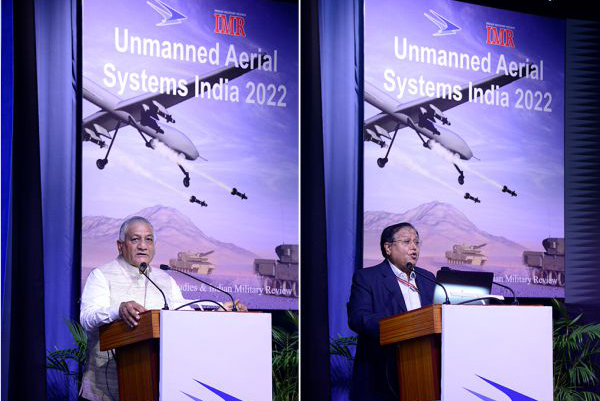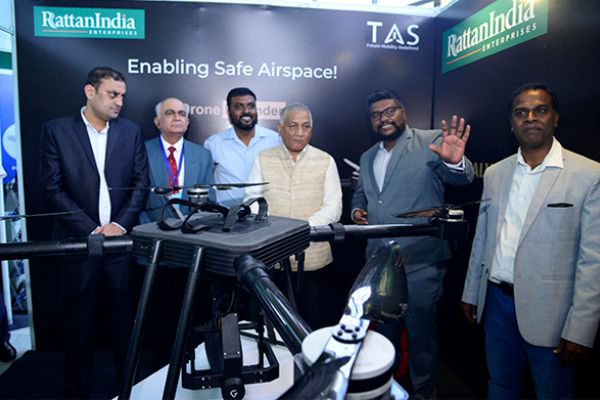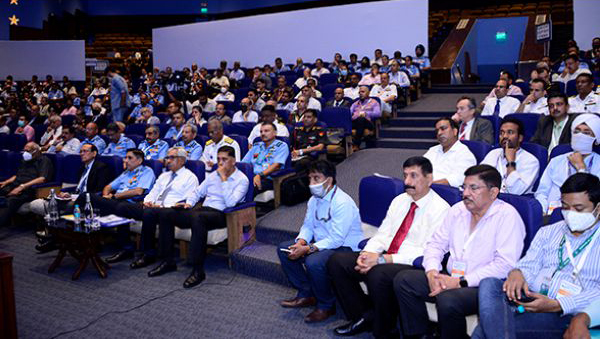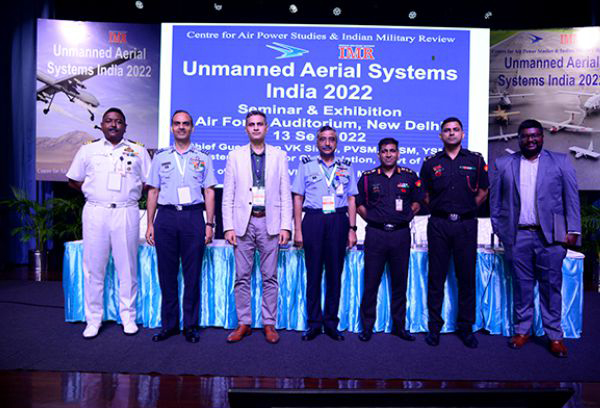
Centre for Air Power Studies (CAPS) and Indian Military Review (IMR) jointly organized a seminar and exhibition on “Unmanned Aerial System India-2022,”on 13th September 2022 at Air Force Auditorium, Subroto Park, New Delhi. The seminar featured distinguished speakers including the Minister of State, industry experts, stakeholders from the armed forces to experts and scholars dealing with Unmanned Aerial Systems and associated allied industries.
The seminar was inaugurated by Gen VK Singh, Union Minister of State for Civil Aviation. The Keynote Address was delivered by Dr VK Saraswat, Member, NITI Aayog.
Session I – Inaugural Session
Welcome Address. Air Marshal Anil Chopra, Director General Centre for Air Power Studies, highlighted the wide range of applications of Unmanned Aerial Systems (UAS) which includes surveillaance, security, logistics, civilian uses in areas of agriculture, transport and many more. He further discussed the increasing significance of the application of UAS in military services. Air Marshal Chopra also highlighted the lessons from the Russia-Ukraine crisis and the increasing usage of drones with proliferating defensive as well as offensive capabilities. He emphasized India’s excellent efforts in developing drone technologies and the development of an unmanned aerial ecosystem. He further underlined India’s potential to become a global drone industry in the coming years.
Inaugural Address. Delivering the Inaugural Address, Gen VK Singh, Union Minister of State for Civil Aviation, traced the history of drones and discussed the increasing efficacy of UAS. He further highlighted the significance of emerging technology along with the increasing role of artificial intelligence (AI) and the internet of things (IoT) in the utilization of drone technology both in the civilian and military domains. He further emphasized on the role that India plays in building this ecosystem. Gen Singh threw light on the Indian government’s plans and initiatives which have been undertaken for making this a reality. Underlining the significance of this technology in the coming years, he elucidated that the government has been supportive of this and that an ecosystem is supportive of research and development in this domain. He also mentioned that the rules and regulations have been revamped with the new drone policy of 25thAugust 2021 which seeks to change the regulatory regime for drones. He stressed the ‘Make in India’ initiative and the increasing use of drones in all sectors, civilian and military alike.
Keynote Address. Delivering the Keynote Address, Dr VK Saraswat, Member NITI Aayog, emphasised the integration of drones into the existing aviation space. In his detailed presentation, Dr Saraswat focused on five main research areas of the UAS which included smart UAV, remote sensing payloads, Robotic UAV payloads, Multi-vehicle networking, Fault-tolerant and robust UAV navigation—i.e., enabling ship-based UAV operations in remote and harsh conditions. He mentioned that as the systems become more and more autonomous with the advancement in technology, it becomes necessary for India to engage in quality and indigenous R&D programs to be initiated in India’s premier higher education institutions such as IITs. Dr Saraswat also spoke about the UAV’s military applications which include strike missions, intelligence & situational awareness, electronic warfare, suppression, and destruction of enemy’s air defence, network node or communication delay, and combat search and rescue. He concluded by making three arguments- (1) Atmanirbharta is necessary in the UAS sector; (2) the necessity to develop extremely good designs and design capabilities with the need for deep R&D; and (3) the efforts in this sector must be qualitative and not just focused on numbers.
Special Talk. Air Marshal Radhakrishnan Radhish, SASO Western Air Command, gave a Special Talk and discussed changes in the UAS systems in the past few years. He mentioned the increasing demand in the civil sector for UAS highlighting the fact that various e-commerce giants also venturing into this domain. Highlighting the need to increase the role of UAS in the IAF, he discussed as to how UAS can play a major role in providing intelligence along with other military responsibilities. Drawing lessons from various conflicts around the world in the past few years, he opined that UAS would complement manned fighter aircraft. He also mentioned that the IAF is developing a road map for the UAS. He also spoke about the increasing use of niche drone technology and swarm drones pointing out that by 2026, India could potentially emerge as the world’s third largest drone market. This is along with the fact that 23per cent of the global drone start-ups are in India.
Special Talk. Lt Gen Ajai Kumar Suri, Director General, Army Aviation also gave a Special Talk and brought in a fresh perspective from the Indian Army. The Indian Army has been using drone technology for the last two decades. He further discussed the need to extrapolate how others are utilizing this surveillance mechanism. The induction of drones into the Services is now unavoidable. He underlined certain challenges, like genuine, indigenous technological development; airspace management; counter drone measures including matching capabilities with those in competition or developing better technology; and outsourcing the task of UAS to civil industry. He stressed that UAS could emerge as a formidable force multiplier and should be employed to its full extent.
Release of Knowledge Paper. Col KV Kuber, Director Defence & Aerospace, E & Y in the presence of the esteemed guests which included presented the EY-IMR Knowledge Paper on the Unmanned Aerial Systems, which was released by the guests.
Session 2—UAV Requirements
The theme of Session 2 was UAV Requirements of the Services, their efficacy, present technologies, and the way forward. The session was chaired by Air Vice Marshal Ashutosh Dixit, ACAS (Plans), Air HQ.
Sameer Joshi, CEO, Newspace Research and Technologies discussed the ‘Design and Development of the UAVs at Newspace for Penetration of Contested Airspace.’ He explained the notion of contested airspace as ‘layered defence’ further discussing the SWOT analysis where he touched upon manned platforms; stealth (manned/unmanned); Medium Altitude Long Endurance (MALE) UAVs and drone swarms. He further discussed the feedback from SWOT analysis which included manned platforms highlighting that they will suffer attrition while penetrating the contested air space. He mentioned that the stealth/low radar cross-section (RCS)in unmanned or manned assets is most effective even though they come with technological or cost implications. He underlined that the significant increase in the number of UAVs will eventually increase the combat capacity and survivability in a contested environment. He discussed that the UAVs are complementary with force-multiplying capabilities, and not the replacement for 4th or 5th-generation manned assets. He further mentioned that the stand-alone non-stealth MALE UAVs will not be able to operate at will in the contested air space, and therefore, will suffer huge attrition. He mentioned that swarm drones offer the best return of investment towards saturation of targets. He further discussed that the requirements of stand-alone small-sized drones will increase exponentially to locate and fix targets right down to the squad level, provided they can survive baseline anti-drone measures. According to Mr. Joshi, Manned Unmanned Teaming (MUM-T) will be an important component of collaborative autonomy as the need in terms of air warfare by the end of 2022.Mentioning that robots are the future warriors, autonomous robots extend military reach into well-defended battle space, operating with greater range and persistence. In the end, he mentioned the salience of AI, highlighting that through AI there is a guarantee to take on dangerous and suicidal missions with minimum possible casualty both in terms of providing greater success in the face of increased threat levels and penetration of well-defended airspace.
Gp Capt NK Chaubey, Director NBC, Air HQ explained the ‘IAF’s UAV Plans.’ He discussed in detail the UAS systems such as Searcher MK-II, Heron and Heron MK-II utilized by the IAF. While explaining their tasks, he explained about the Imaging EQ/IR and SAR, SIGINT gathering, COMINT gathering, laser designation, RPA assisted helicopter and fighter strike, battle damage, assessment, search & rescue, base-defence missions, HADR missions, live coverage of various tests and trials. While discussing the way forward, he discussed the MALE class remotely pilot aircraft with enhanced capabilities including uninhabited combat air vehicle (UCAV), loiter munitions, UAVs for Base Defence, indigenous productions for sustenance, and inter-service operations. Discussing the Manned Operation and Intelligence Centre (MOIC) section, he focused on the enhanced capabilities of the IAF to generate intelligence; centralize a hub for archival and analysis of all ISR data; and simultaneous control of UAVs through SATCOM.
Col Kumar Gaurav, Col Avn-10 (RPAs), Army Aviation Directorate, Army HQ, shared his views on ‘Army’s HALE and MALE UAV Requirements.’ He explained that HALE RPAs and MALE RPAs were the perfect examples of splitter-shooter platforms. They can engage with the target with onboard weapon systems which include laser-guided bombs, missiles, and anti-tank missiles. Similarly, MALE RPA can acquire the target, get precise data of the target, and transfer data to long-range vectors. Col. Gaurav also discussed that RPA AO/payload has the capacity to carry out overall damage assessment and re-engage the target by the HALE UAVs.
Lt Col Shubham Madan, GSO-1 (Equipment), Infantry Directorate, Army HQ spoke on ‘Army’s Tactical UAV Requirements.’ He identified four areas – logistics, surveillance, enemy threat, and counter-drone operations, where UAS were needed for infantry observation requirements. He mentioned that as part of logistics, the requirements criteria included 5500 metres AMSL, 1000m AGL, 20-50 kg, and 10-15 km. While mentioning the logistical challenges he discussed the road infrastructure in forwarding areas, winter cut-off of posts, and last mile connectivity. In terms of surveillance, the requirements were highlighted as 6000m, 1000m AGL, vertical take-off and landing and man-portable. He also highlighted the requirements by terrain, i.e., in the North-East region, J&K, plains and deserts. While discussing the main challenges for surveillance, he mentioned the forwarded areas, varied terrains and lack of landing grounds. For counter-drone operations, he raised the questions of range and cost-effectiveness. Further, he mentioned that counter drones should be able to detect, identify and destroy the target while identifying the enemy threat as – Armed and ULP GMs.
Cdr Hemant Shekar, Commander (AW)-RPA, Naval HQ focused on ‘Navy’s experience with drones and future plans.’ He highlighted the restricted speed, electromagnetic radiation and susceptibility to detection, RPA’s detectable by C/D radars of ships, range limited to line of sight, and operational capability in fair weather only. The key focus of the Navy has been to enhance the capabilities in the areas of long-range anti-submarine warfare (ASW), surveillance and reconnaissance. During the discussion, he highlighted that currently, the Indian Navy had UAVs which have navigation/control features combined with specialised sensors, mainly aimed at achieving precise surveillance over the enemy territories. However, there is a need for the UCAVs to go beyond surveillance into a new dimension with their weaponised capability to engage in air-to-surface (land/water) and even air-to-air targets.
Nagendran Kandasamy, CEO Throttle Aerospace Systems (TAS) discussed ‘How Drone Defender enables safer airspace?’ The Drone Defender is loaded with 13 pre-programmed modes to lock, track and neutralize rogue drones. It can effectively neutralise threats without any human intervention. It aims to provide a first-of-a-kind capability to the Indian defence forces to discard rogue drones flying over unauthorised airspace. This is in context with the rising instances of drone-based aerial threats to restricted installations under defence and private airspace. According to Kandaswamy, this can be considered to be a key milestone in India’s journey of self-reliance in defence preparedness.
Session 3—Industry’s Potential and Capabilities
The theme of Session 3 was Industry’s Potential and Capabilities. It was chaired by Rear Adm AN Pramod, ACNS (Air), Naval HQ.
Gp Capt Sudhir Verma, Retd, Aerial IQ India discussed ‘Atmanirbharta in UAS Technology.’ He recounted the journey of Aerial IQ in the manufacture of drones. He mentioned that reaching the desired capability takes technology and time. So, significant effort and time have to be spent on the research and development of UAVs. He further discussed the support provided by the Government of India to drone startups mentioning that this will boost indigenous manufacturing, and the drone certification scheme to ensure safety and quality requirements are a few positive steps taken by the government in favour of the Indian drone industry. Gp Capt Verma discussed Aerial IQ’s initiative to develop tethered drones, which is unique and has had considerable sales due to its great potential. He highlighted that Aerial IQ is totally indigenous with the aim to make drones that fit into the requirements of the industry.
Ravi Hazarika, Sales Director, PBS India gave a talk on “PBS Engines for Unmanned Aerial Systems.” He explained the company’s focus on in-house development, production, testing and certification of turbojet, turboprop and turboshaft engines. He further elaborated that the company has expertise in engine testing. Discussing PBS TJ40-G1, he highlighted that it can be used with the hybrid electric motor. This is basically a turbojet engine that is meant for UAV systems, such as target drones and decoy drones, which also has low weight as one of its qualities. The company has also produced PBS TJ80, having the best thrust-to-diameter ratio. It is a turbojet engine designed for missiles, target drones and UAVs. The PBS TJ150 by the same company is a turbojet engine having higher thrust and a smaller diameter. It is light in weight with a powerful thrust of up to 1500 Newton along with low fuel consumption.
Col KV Kuber, Director Defence and Aerospace, E&Y gave the “Industry Perspective on UAS.” He mentioned that high economic growth in India has boosted the country’s entire UAV/Drone startup ecosystem. Further highlighting that co-production was the key for Atmanirbharta, he mentioned that this would help in reducing the input cost. So, there is a need to involve private industry in R&D. He highlighted that Atmanirbharta also meant that whatever indigenous products that any company produces should have the ability and confidence to improve on it on a much larger scale. He elaborated on ongoing drone initiatives in Indian firms like HAL and Adani Defence. He also spoke about India’s UAS exports like the Garuda drone which is exported to Malaysia. He stressed that while capability development can be done through technological developments, capacity building will be achieved through a robust industrial framework. He defined exports to be numerators, and production to be the denominator. According to him, a healthy balance between these two means a state of mutual interdependence, where a greater denominator reflects lacking abilities and the presence of vulnerabilities.
Session 4— Innovations and Research & Development
The theme of their session was Innovations, Research & Development. It was chaired by Cmde Vivek Dahiya, Cmde (SR), Naval HQ. The session focused on discussing the phenomenon of disruptive technologies taking over and becoming mainstream.
Chandreyi Suhas, Scientist F, ADE, DRDO gave a presentation on ‘Latest developments in UAVs.’ Briefly mentioning the future battlespace which will comprise manned, unmanned and hybrid aerial systems, she discussed in detail ADE’s product portfolio, including Pilotless Target Vehicles (Lakshay), Nishant SR-UAV, Panchi UAV and Rustom-1 (Short Range UAV for Reconnaissance). She also highlighted the aero materials, especially composites, strike aircraft variants, cruise missiles, aspects of stealth/ low observability technologies, RCS reduction technologies and radar absorbing paints.
Ashish Sharma, Director, WB Electronics, India, gave a brief overview of WB Electronics, India. He emphasized the company’s areas of activity which are crucial for the transfer of technology. He discussed in detail the Topaz Integrated Combat Management System, U-GATE Dismounted observation and unmanned system, and other systems offered by WB Electronics.
Wg Cdr Anand Pethia, Retd, Adani Defence and Ido Lichter, Vice President, UAS Engineering, Elbit Systems together gave a talk on ‘Evolution of Unmanned Aerial Systems from Segregated to Un-segregated Airspace.’ Pethia stressed on the importance of shifting focus from fighter operations to UAS, which will help to bridge the shortage of squadrons in a two-front war. Pethia elaborated on ‘the India Drone Rules 2021’ and explained how authorities are opening up the skies for drone testing in limited airspace. Ido underlined the importance of military certification, core standards of certification, the basis of certification, and why “certification is not enough and being ‘certified’ is now needed.” Further, Ido emphasized on the need for rigorous testing for building standards to reach a mature level of conformity.
Col Rajan Desai, Col Artillery & Aviation, Army Design Bureau, spoke on ‘Swarm Drones’ and brought out the enhanced significance of indigenous swarm drone technologies, highlighting the advantages of cost and operability, that have been observed in recent deployment scenarios. He underlined the design gaps of the drone industry which included the inability to test in high altitudes and extreme terrains. He elaborated that the Indian government is supporting the domestic start-up ecosystem through various policies, competitions and initiatives.
Wg Cdr Sarang Vashisht, Air HQ, discussed the ‘Meher Baba Swarm Drones Competition’ which began in October 2018, to honour Late Air Cdr Meher Singh, DSO.
Session 5—Counter UAVs
The theme of this session was “Counter UAVs”. It was chaired by Air Vice Marshal Rakesh Sinha, ACAS Operations (Offensive), Air HQ.
Brig Manish Kumar, Brig (Ops & C2), Army Air Defence Directorate, presented his views on ‘Countering the UAV Threat.’ He spoke on the significant targeting and destruction of drones in recent conflicts between Armenia-Azerbaijan and Russia-Ukraine. He emphasized the ‘urgent vs important’ aspects in the development of counter-drone capabilities and the key precepts of the UAS like the command-and-control systems, SATCOM, telemetry, navigation, positioning, and means of propulsion. He also explained the mitigation philosophy based on the threat environment and the importance of control through a centralized structure.
Azeez P, Scientist F, LRDE and V Kishore Kumar, Scientist D, DLRL, DRDO, together spoke on the DRDO developed ‘D-4 Anti-drone System.’ The speakers explained the Drone Detect, Deter and Destroy system (D4S) – the first indigenously developed anti-drone system to be inducted into the Indian Armed Forces. While highlighting the usage of counter-drone technology for surveillance to identify and mitigate through hard and soft-kills, the speakers also delved into the basic issues faced by the counter-drone systems, which included the size of drones and the importance of automatic classification between drones and other entities. Their discussion also highlighted challenges like detection effectiveness, false positives and false negatives, collateral damage and signal disruption.
Air Marshal Anil Chopra, Director General, CAPS gave the Closing Remarks and Maj Gen Ravi Arora, Chief Editor, Indian Military Review gave the vote of thanks.
Report prepared by: Dr. Anu Sharma, Dr. Ngangom Dhruba Tara Singh, Divyanshu Jindal, Prachi Lokhande and Jay Desai.




















